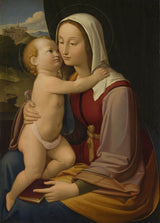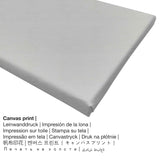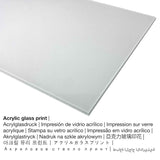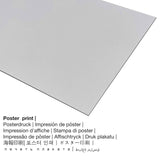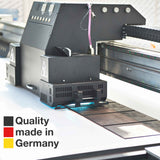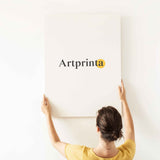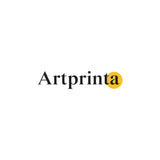Johann Friedrich Overbeck, 1818 - The Virgin and Child - fine art print
Tax included. Shipping calculated at checkout.
The piece of art "The Virgin and Child" painted by Johann Friedrich Overbeck as your new art copy
"The Virgin and Child" is a painting created by Johann Friedrich Overbeck in 1818. The more than 200 years old original was made with the following size: 65,8 x 47,1 cm and was painted with the medium oil on wood. This artpiece is included in the Thorvaldsens Museum's digital art collection in Copenhagen, Denmark. With courtesy of: Johann Friedrich Overbeck, The Virgin and Child, 1818, Thorvaldsens Museum, www.thorvaldsensmuseum.dk (license - public domain).Additionally, the work of art has the creditline: . What is more, the alignment is portrait with a side ratio of 1 : 1.4, meaning that the length is 29% shorter than the width.
What kind of material do you preferr?
We offer a range of various materials and sizes for every product. You can pick your preferred material and size among the following options:
- Aluminium dibond print (metal): Aluminium Dibond prints are prints on metal with a true depth effect - for a modern look and a non-reflective surface. For the Aluminium Dibond option, we print your selected artwork on the aluminium white-primed surface. The colors are luminous in the highest definition, details of the print are very clear. The direct print on aluminium is the most popular entry-level product and is an extremely contemporary way to showcase fine art reproductions, because it draws attention on the artwork.
- Poster print (canvas material): A poster print is a UV printed canvas paper with a fine surface structure, which resembles the original artwork. It is ideally qualified for framing your art print using a custom frame. Please bear in mind, that depending on the absolute size of the poster print we add a white margin of around 2-6cm around the print, which facilitates the framing.
- Canvas: The canvas direct print is a printed cotton canvas stretched on a wood stretcher. The great advantage of canvas prints is that they are relatively low in weight, which implies that it is easy to hang your Canvas print without any wall-mounts. Canvas prints are suitable for all types of walls.
- The acrylic glass print: The acrylic glass print, often described as a print on plexiglass, will change your favorite original into marvellous home decoration. Your favorite work of art is made with state-of-the-art UV printing machines. It makes vibrant, stunning color tones. The great benefit of an acrylic glass art print is that contrasts and also minor details will be visible thanks to the delicate gradation in the picture.
Legal note: We try the best we can in order to describe the products as accurate as possible and to display them visually in our shop. Please bear in mind that the tone of the print materials and the imprint might vary somehwat from the image on your device's monitor. Depending on the settings of your screen and the condition of the surface, colors can unfortunately not be printed one hundret percent realistically. In view of the fact that our fine art prints are processed and printed by hand, there might as well be minor discrepancies in the motif's exact position and the size.
About this item
| Print product type: | wall art |
| Method of reproduction: | digital reproduction |
| Manufacturing method: | digital printing |
| Production: | made in Germany |
| Stock type: | on demand production |
| Intended product use: | gallery wall, wall gallery |
| Artwork orientation: | portrait format |
| Aspect ratio: | 1 : 1.4 |
| Meaning of image aspect ratio: | the length is 29% shorter than the width |
| Available reproduction fabrics: | canvas print, metal print (aluminium dibond), poster print (canvas paper), acrylic glass print (with real glass coating) |
| Canvas print (canvas on stretcher frame): | 50x70cm - 20x28", 100x140cm - 39x55" |
| Acrylic glass print (with real glass coating) options: | 50x70cm - 20x28", 100x140cm - 39x55" |
| Poster print (canvas paper) size options: | 50x70cm - 20x28" |
| Aluminium dibond print sizes: | 50x70cm - 20x28", 100x140cm - 39x55" |
| Art print framing: | not available |
Background information about the original work of art
| Artwork name: | "The Virgin and Child" |
| Artwork classification: | painting |
| Umbrella term: | modern art |
| Time: | 19th century |
| Created in the year: | 1818 |
| Approximate age of artwork: | more than 200 years old |
| Original medium of artwork: | oil on wood |
| Dimensions of the original work of art: | 65,8 x 47,1 cm |
| Museum: | Thorvaldsens Museum |
| Location of museum: | Copenhagen, Denmark |
| Museum website: | Thorvaldsens Museum |
| License type of artwork: | public domain |
| Courtesy of: | Johann Friedrich Overbeck, The Virgin and Child, 1818, Thorvaldsens Museum, www.thorvaldsensmuseum.dk |
Artist details
| Artist: | Johann Friedrich Overbeck |
| Additional names: | Overbeck Johann Friedrich, Overbeck Joh. Friedrich, overbeck fr., Johann Friedrich Overbeck, Joh. Friedrich Overbeck, fritz overbeck, Overbeck J. Fr., fr. overbeck, Overbeck Friedrich, Overbeck F., Friedrich Overbeck, Overbeck, Joh. Fr. Overbeck, Overbeck J. F., overbeck fritz |
| Gender of the artist: | male |
| Artist nationality: | German |
| Jobs of the artist: | illustrator, painter, poet, writer |
| Country: | Germany |
| Artist category: | modern artist |
| Died aged: | 80 years |
| Born: | 1789 |
| Born in (place): | Lubeck, Schleswig-Holstein, Germany |
| Year of death: | 1869 |
| Deceased in (place): | Rome, Roma province, Lazio, Italy |
Copyright ©, www.artprinta.com (Artprinta)
What does the curator team of the Thorvaldsens Museum write about this work of art created by Johann Friedrich Overbeck? (© Copyright - Thorvaldsens Museum - Thorvaldsens Museum)
The Madonna is impersonal, totally lacking sensuality, delicate as porcelain and expressive precisely of the piety to which Overbeck dedicated his life and for which he strove in his art. The child is looking at his mother, while she for her part is staring straight ahead. Her finger in the book shows where she has her thoughts. She is thinking of the suffering and death that await the Son of Man, but she is not weighed down, for she also knows the continuation of the story. In the background, Overbeck has painted a path leading up the mountain. At the top, the mountain is surmounted by a town characterised by a mysterious ship-like building. It may be that this strange building in Overbeck’s painting is intended to remind us of the Ark, which naturally has come to stand as a symbol of redemption and eternal life. In other words, Mary foresees not only the death of Christ, but also His resurrection. Overbeck, who derived from Protestant North German, converted to Catholicism in 1813 and spent the rest of his life in Rome. He is considered the most important member of the group of artists who came to Rome in 1810 and became known as the Nazarenes because they dressed in long robes, painted religious motifs and let their hair grow like that of Jesus of Nazareth. They modelled themselves on the artists of the High Renaissance such as Michelangelo, Titian and especially Raphael. Thorvaldsen and Overbeck knew and respected each other. In 1814, perhaps in order to give Overbeck financial support, Thorvaldsen commissioned a series of drawings based on his Alexander Frieze, which were to serve as patterns for prints in a book, and at a later date there was also talk of the two working together in connection with the design of the Gutenberg monument in the city of Mainz.

